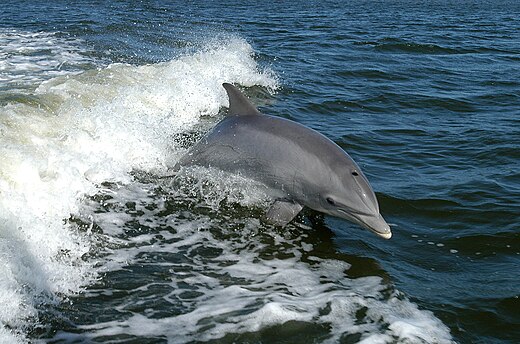dolphins.html">Dolphins are aquatic mammals belonging to the family Mammalia, order Cetidae, and are closely related to whales and porpoises. There are about 40 species in total. dolphins.html">Dolphins are loved for their intelligence, affectionate behavior and often performing jumps on the water. These agile animals are known for their exceptional learning abilities, complex problem-solving, and tool-using behaviors.

Size: The body length of dolphins is generally between 2 and 4 meters, and large species such as killer whales (also known as killer whales or killer whales, a type of dolphin) can be more than 8 meters long.
Shape: They usually have a streamlined body, a pair of pectoral fins and a tail fin, a raised dorsal fin in the middle, and a short beak that is usually prominent on the head.
Respiration: As mammals, dolphins breathe through breathing holes located above their heads. They are not fish and cannot breathe underwater, so they need to come up to the surface periodically to breathe air.
Senses: Dolphins have excellent auditory senses and can detect sound waves and echoes underwater. They also echolocate and communicate with each other through sound waves.
Sociality: Dolphins are social animals and often live in fixed groups. These groups are called "dolphin schools" or "dolphin schools". The size of the group ranges from a few individuals to hundreds.
Food habits: They mainly feed on fish and squid. Different species of dolphins use different hunting techniques depending on their habitat and available resources.
Reproduction: Female dolphins give birth to only one pup during pregnancy (usually a little over a year) and are able to maintain a close mother-child relationship with them for several years. Young dolphins are usually born with their heads facing backward to avoid drowning.
Communication: Dolphins communicate using a range of sounds, including clicks, whistles and other frequencies of sound waves. Dolphins have unique "voiceprints" that allow them to identify each other by their sounds.
Dolphins are widely distributed in warm waters around the world, especially in temperate and tropical waters. A few species such as killer whales can be found in cold polar waters.
The survival status of many dolphin species is worrying. Some species are threatened by overhunting, habitat destruction, water pollution, ocean noise disturbance, and entrapment in fishing nets. To protect dolphins, many countries and regions have restricted or banned hunting of dolphins, promoted sustainable fishing methods to reduce accidental catches, and made global efforts to protect their habitats.
In terms of interactions with humans, dolphins are extremely popular in marine parks and aquariums due to their friendly nature and performative behaviors. Additionally, dolphin therapy, an alternative therapy that utilizes interaction with dolphins as a therapeutic method, although not widely scientifically proven, can have a positive psychological impact on patients in some cases.
However, marine biologists and conservationists generally discourage people from interacting with wild dolphins because it could disturb their natural behavioral patterns and cause harm to the dolphins or humans. Protecting the marine environment is not only for the sake of dolphins and other marine life, but also for the overall health of the marine ecosystem and the long-term well-being of humans.
animal tags: dolphin
We created this article in conjunction with AI technology, then made sure it was fact-checked and edited by a Animals Top editor.